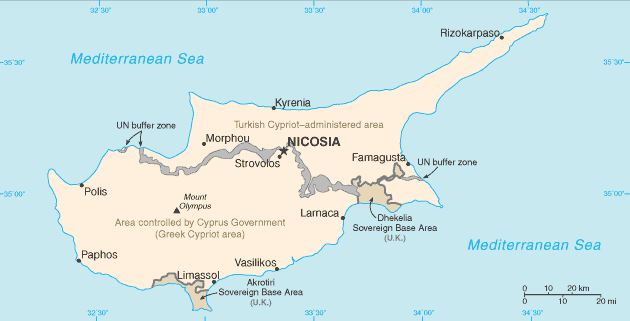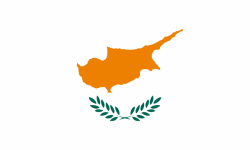Republic of Cyprus
Related Categories:
 Cyprus seeks new Flag - BBC
Cyprus seeks new Flag - BBCThe United Nations has advertised a competition for artists and musicians to come up with a new national flag and a new national anthem for the divided island of Cyprus if a deal is reached over its re-unification.
news.bbc.co.uk/2/
The white flag was chosen for the young Cyprus as a sign of peace among the two antagonistic communities living there.
www.fotw.us/flags/cy.html Cyprus - wikipedia.org
The name Cyprus has a somewhat uncertain etymology. Suggestion is that it comes from the Greek word for the Mediterranean cypress tree, or even from the Greek name of the henna plant.
en.wikipedia.org/
Since 1974, Cyprus has been divided de facto into the government-controlled two-thirds of the island and the remaining one-third of the island, which is administered by Turkish Cypriots. Greek and Turkish Cypriots share many customs but maintain distinct identities based on religion, language, and close ties with their respective "motherlands." Greek is predominantly spoken in the south, Turkish in the north. English is widely used. Cyprus has a well-developed system of primary and secondary education. The majority of Cypriots earn their higher education at Greek, Turkish, British, and other European or American universities. Both the Turkish and Greek communities have developed private colleges and state-supported universities.
Cypriot culture is among the oldest in the Mediterranean. By 3700 BC, the island was well inhabited, a crossroads between East and West. The island fell successively under Assyrian, Egyptian, Persian, Greek, and Roman domination. For 800 years, beginning in 364 AD, Cyprus was ruled by Byzantium. After brief possession by King Richard I (the Lion-Hearted) of England during the Crusades, the island came under Frankish control in the late 12th century. It was ceded to the Venetian Republic in 1489 and conquered by the Ottoman Turks in 1571. The Ottomans applied the millet system to Cyprus, which allowed religious authorities to govern their own non-Muslim minorities. This system reinforced the position of the Orthodox Church and the cohesion of the ethnic Greek population. Most of the Turks who settled on the island during the three centuries of Ottoman rule remained when control of Cyprus--although not sovereignty--was ceded to Great Britain in 1878. Many left for Turkey during the 1920s, however. The island was annexed formally by the United Kingdom in 1914 at the outbreak of World War I and became a crown colony in 1925.
Cyprus gained its independence from the United Kingdom and established a constitutional republic in 1960, after an anti-British campaign by the Greek Cypriot EOKA (National Organization of Cypriot Fighters), a guerrilla group that desired political union, or enosis, with Greece. Archbishop Makarios, a charismatic religious and political leader, was elected president.
Shortly after the founding of the republic, serious differences arose between the two communities about the implementation and interpretation of the constitution. The Greek Cypriots argued that the complex mechanisms introduced to protect Turkish Cypriot interests were obstacles to efficient government. In November 1963, President Makarios advanced a series of constitutional amendments designed to eliminate some of these special provisions. The Turkish Cypriots opposed such changes. The confrontation prompted widespread intercommunal fighting in December 1963, after which Turkish Cypriots ceased to participate in the government. Following the outbreak of intercommunal violence, many Turkish Cypriots (and some Greek Cypriots) living in mixed villages began to move into enclaved villages or elsewhere. UN peacekeepers were deployed on the island in 1964. Following another outbreak of intercommunal violence in 1967-68, a Turkish Cypriot provisional administration was formed.
In July 1974, the military junta in Athens sponsored a coup led by extremist Greek Cypriots against the government of President Makarios, citing his alleged pro-communist leanings and his perceived abandonment of enosis. Turkey, citing the 1960 Treaty of Guarantee, intervened militarily to protect Turkish Cypriots.
In a two-stage offensive, Turkish troops took control of 38% of the island. Almost all Greek Cypriots fled south while almost all Turkish Cypriots fled north. Since the events of 1974, UN peacekeeping forces have maintained a buffer zone between the two sides. Except for occasional demonstrations or infrequent incidents between soldiers in the buffer zone, the island was free of violent conflict from 1974 until August 1996, when violent clashes led to the death of two demonstrators and escalated tension. The situation has been quiet since 1996.
www.state.gov/r/
Introduction
About
Contact
Symbols in The News
Interpret this Symbol
AAC
African
AI
Alchemy
Alphabets
Ancient
Animal Symbolism
Architecture
Art
Articles
Astrology
Baha'i
Blissymbolics
Blueprint Symbols
Buddhist
Celtic Symbols
Cemetery
Chinese Symbols
Christian
Circle
City
Codes
Color
Conlangs
Crop Circles
Danger
Da Vinci Code
Designing Logos
Dictionaries
Dreams
Education
Egyptian Symbols
Electrical
Emoticons
Find Images
Fonts
Food
Fraternity
Hamsa
Healing
Heraldry
Hermetic
Highway Signs
Hindu
History
Hobo
Holiday
Icons
iConji
Islamic
Jain Symbols
Japanese, Kanji
Jewish
Justice
Law
Literary Symbolism
Mandalas
Map
Masonic
Math, Number
Meaning of Names
Medical
Middle East
Military
Miscellaneous
Money
Music
Mythology
Native American
Playing Cards
Power
Psychology
QiQiiKhu
Reiki
Religious
Runes, Norse
Sacred Geometry
Scientific
Science Fiction
Sorority
Sports
Symbols in the News
Tattoos
ThirteenSymbols
Tree of Life
Ursprache
Videos
Visual Languages
Weather
Web Codes
Wicca
Words
Writing Systems
Braille
Coinherence
Coptic
Cuneiform
Easter Island
Etruscan
Happy Human
Hebrew
Kokopelli
Linear B
Lotus
Love Symbols
Mandorla
Moon Alphabet
Nine Pointed Star
Om
Oz
Phonetic
Scarab Beetle
Silent
Theosophy
Unifon
About
Contact
Symbols in The News
Interpret this Symbol
AAC
African
AI
Alchemy
Alphabets
Ancient
Animal Symbolism
Architecture
Art
Articles
Astrology
Baha'i
Blissymbolics
Blueprint Symbols
Buddhist
Celtic Symbols
Cemetery
Chinese Symbols
Christian
Circle
City
Codes
Color
Conlangs
Crop Circles
Danger
Da Vinci Code
Designing Logos
Dictionaries
Dreams
Education
Egyptian Symbols
Electrical
Emoticons
Find Images
Fonts
Food
Fraternity
Hamsa
Healing
Heraldry
Hermetic
Highway Signs
Hindu
History
Hobo
Holiday
Icons
iConji
Islamic
Jain Symbols
Japanese, Kanji
Jewish
Justice
Law
Literary Symbolism
Mandalas
Map
Masonic
Math, Number
Meaning of Names
Medical
Middle East
Military
Miscellaneous
Money
Music
Mythology
Native American
Playing Cards
Power
Psychology
QiQiiKhu
Reiki
Religious
Runes, Norse
Sacred Geometry
Scientific
Science Fiction
Sorority
Sports
Symbols in the News
Tattoos
ThirteenSymbols
Tree of Life
Ursprache
Videos
Visual Languages
Weather
Web Codes
Wicca
Words
Writing Systems
Braille
Coinherence
Coptic
Cuneiform
Easter Island
Etruscan
Happy Human
Hebrew
Kokopelli
Linear B
Lotus
Love Symbols
Mandorla
Moon Alphabet
Nine Pointed Star
Om
Oz
Phonetic
Scarab Beetle
Silent
Theosophy
Unifon

